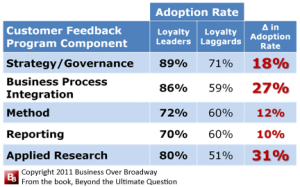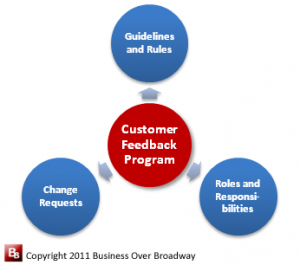
A CEM program consists of a set of organized actions that support the goal of CEM. While a CEM program has many moving parts, an easy way to organize those pieces is depicted in the figure on the right. A CEM program has six major components:
- Strategy addresses how companies incorporate CEM into their long-term plans to help achieve its objectives and goals
- Governance describes the formal policy around the CEM program: Rules, Roles, Requests
- Business Process Integration involves embedding CEM processes/data into other business operations
- Method addresses the means by which customer feedback is collected
- Reporting addresses analysis, synthesis and dissemination of customer feedback
- Research is concerned with how companies provide additional customer insight by conducting deep dive research using different types of customer data

Best Practices in Customer Experience Management
The success of your CEM program depends on how you structure it. In a study examining the differences between loyalty leading companies and loyalty lagging companies, I found that loyalty leaders, compared to their loyalty lagging counterparts, adopted specific business practices in how they approach CEM. Generally speaking, I found that loyalty leading companies have top executive support of the CEM program, communicate all aspects of the program companywide, and integrate customer feedback to other business data (operational, financial, constituency) to gain deeper customer insights. I will cover these areas in more detail below.
Strategy and Governance
Strategy addresses the overarching guidelines around the company’s mission and vision regarding the company objectives/goals. Governance addresses the guidelines and rules (how the program is directed); roles and responsibilities (how data are used and by whom); and change requests (how changes to the program are made).

Consider using CEM information to set company strategy and formalize the CEM program so everybody knows the rules of the program and their responsibilities. A customer culture is created by effective and consistent communications about the customers and their needs. Use actual voice of the customer to drive interest in your CEM program.
Business Process Integration
Business Process Integration addresses how the company incorporates CEM processes and data into business operations. Loyalty leaders incorporate CEM metrics into executive dashboards and use them for compensation decisions. You might consider consolidating all sources of customer feedback using an Enterprise Feedback Management (EFM) vendor. I do not see too much distinction across different EFM vendors. They each offer pretty much the same set of solutions. The key is to find an EFM vendor who knows that CEM is more than just an adoption of their technology. It is about people and processes (and other technology), too, and how their technology addresses your unique needs.
CEM is the process of understanding and managing customers’ interactions with and perceptions about the company/brand.
The next step would be to combine the attitudinal data (EFM data) with Customer Relationship Management (CRM) data to get a complete picture of the customer. Remember, CEM is about customers’ perceptions and interactions. Combining these two types of customer data increases the
value of the customer data by allowing you to find deeper customer insights you could not find in any single data source (e.g., creating customer-centric operational metrics, setting employee training standards). Finally, be sure to communicate all aspects of your CEM program to the entire company and deliver content that matches the needs of the recipient. The content for these types of communications would include program goals, policy changes, governance rules and feedback results, to name a few.
Method and Reporting
CEM programs require a solid understanding of customers’ perceptions. The Method of the CEM program addresses how customer feedback is collected and what gets measured. CEM leaders acquire feedback through many different channels (social media, surveys and brand communities) and collect different customer metrics (experience, loyalty, sentiment) (). Loyalty leaders employ the power of the Web to collect customer feedback. Web surveys provide an easy way for customers to give feedback and data are always up to date.
Getting the right information to the right people at the right time is crucial.
Ensure your customer survey asks the right questions. Measuring the customer experience (CX) requires fewer questions than you think. It turns out that around 7 general CX questions will tell you just as much about what drives customer loyalty as 20-30 specific CX questions will.
Customer metrics play a crucial role in understanding the health of the customer relationship. Don’t go overboard on the customer metrics. As a general rule, select/use a few key customer metrics. Make sure your customer metrics are reliable, valid and useful.
Every CEM program must include measures of customer loyalty. Because the ultimate goal of a CEM program is to improve the customer experience to optimize customer loyalty, you need to ensure you ask the right customer loyalty questions. Expand your thinking about customer loyalty and include customer loyalty questions that tap the different ways your customers can show their loyalty toward your company and brand. In addition to measuring your own performance, assess your relative performance (compared to your competitors). Understanding your relative performance helps you identify your competitive dis/advantage to improve up/cross-selling.
Reporting deals with how customer feedback data are analyzed, synthesized and disseminated throughout the company. When reporting customer feedback, focus on both the individual-level reporting and segment-level reporting. This dual micro/macro approach ensures you are able to quickly address a specific problem for a particular customer (e.g., micro approach) and deal with common problems for large customer segments (e.g., macro approach). In the latter approach, be sure to use appropriate statistical analysis to uncover the reasons why customers are loyalty/disloyal.
Applied Research
Research addresses how the company gains additional customer insight through deep dive analyses of customer data. Loyalty leaders employ linkage analysis by combining different data sources (e.g., CEM, Operational) to get a better understanding of the causes and consequences of customer loyalty.
Linkage analysis uncovers deeper customer insights and increases the value of disparate data sources (e.g., operational, financial, constituency)
Loyalty leaders link CEM metrics to three data sources. Financial data are linked to CEM metrics to determine the value of the CEM program. Operational metrics are linked to CEM metrics to understand which call center metrics are important to the customer. Link constituency metrics (e.g., employee, partner) and CEM metrics to understand company ecosystem.
Summary
Successful CEM requires a formalized, integrated process that delivers the right customer insights to the right people at the right time. An effective CEM program is one that is supported by senior management. Customer insights are used to manage marketing, sales and service processes through integration with other customer data. This combination of behavioral and attitudinal data allows for deeper customer insight to improve the customer experience. EFM and CRM vendors have a great opportunity to demonstrate their combined value on the CEM space.

The Practice of Customer Experience Management: Get the Paper
The content of this blog post is in my new 5-page report, The Practice of CEM. I set up a way for you to get the 5-page paper and give me short feedback on topics you want me to write about. All you have to do is tweet about the report and it is yours. Simply click the cover of the paper (to the right) to send a tweet about the report via Pay with a Tweet and you will have immediate access to download the paper. Download requires a tweet or a Facebook like.
Customer Feedback Program Diagnostic (CFPD)
Do you adopt CEM best practices? Complete the Customer Feedback Program Diagnostic, a free self-assessment survey, and get your score and brief summary upon survey completion.


